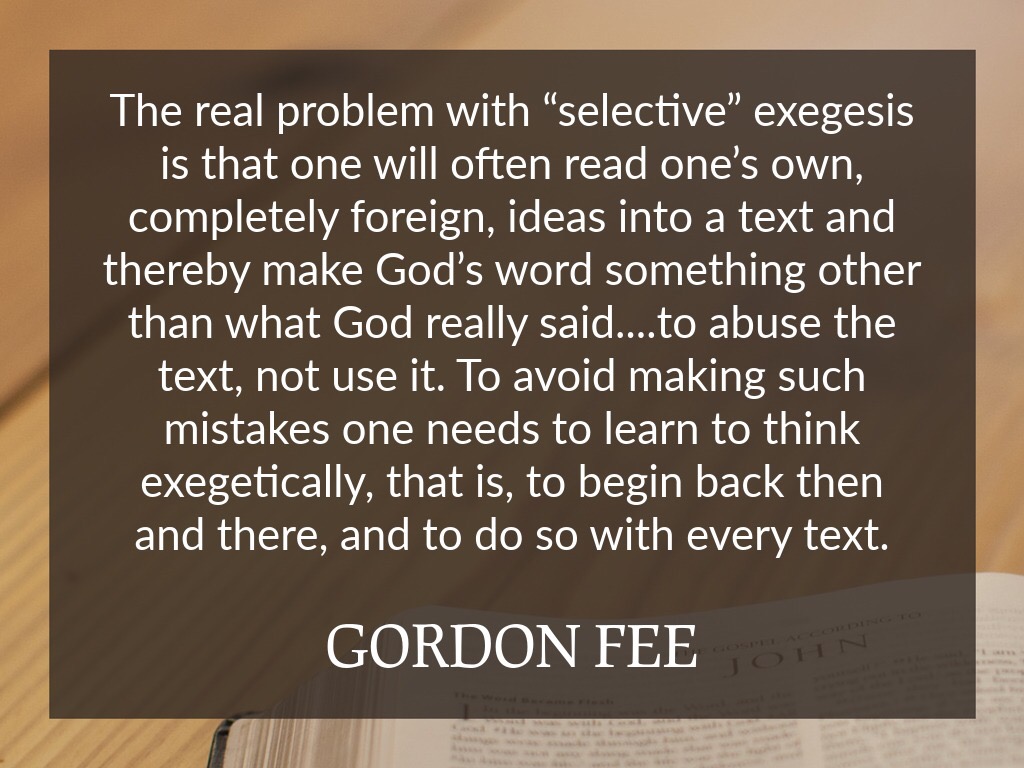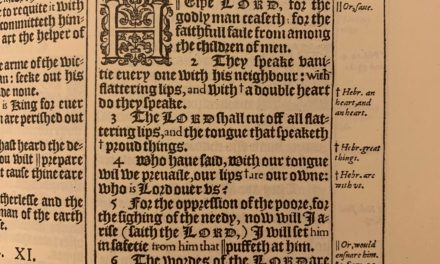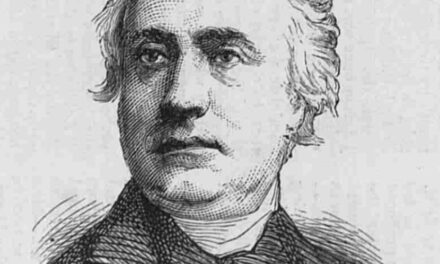Until a few years ago, moral behavior in my life was often guided by long lists of extra-biblical rules and “principles” to help us figure out God’s will. One of the proof-texts that appeared on virtually every one of these lists was I Thess. 5:22, which, in the KJV, commands us to avoid even the mere “appearance of evil.” That is, even if an activity wasn’t inherently wrong, if it might look wrong to others, it was still a sin.
Why can you rent VHS tapes to watch at home, but not go to a movie theater? Well, because someone might think you were there to see a “bad” movie. Why is it ok to swim in the backyard, but never in a public pool? Well, because someone might see you, and know that you thought mixed swimming was ok. Why is it wrong to be in a bar, even if you don’t drink (or even, to walk by one)? Because of what others might think. Why can you wear shorts or pants at home but not in public? You get the idea. Who we could hang out with, where we could go, what we could do – all shaped, in part at least, by how it would look to others.
The Tragic Abuse Of “Abstaining”
This ethical “principle” finds its basis today in the KJV rendering of I Thess. 5:22, “Abstain from all appearance of evil.” And while many may with sincerity use it to guide their own behaviors, genuinely seeking to follow God, others wield it like a weapon to impose legalistic and unbiblical rules on others. The sad result is that it ends up breeding a culture that is obsessed with the perceptions of others. In religious cultures focused on external appearances, the desire to live for God and do his will is slowly replaced with an obsession to make sure everyone else knows how godly you are. Appearing moral becomes as important, or even more important, than actually being moral. We became obsessed with protecting what we called our “testimony.” That’s an odd use of this word. Instead of referring to “testifying” to God’s grace, we meant it more in reference to building a monument to our reputation for godliness.
In religious cultures focused on external appearances, the desire to live for God and do his will is slowly replaced with an obsession to make sure everyone else knows how godly you are.
To be sure, the Old Testament (especially the Wisdom literature) speaks of the value of “a good name,” which usually means, a reputation of integrity, known for giving to the poor, which which leaves a lasting legacy (Prov. 22:1, 2, 4, 7, 9, 16; Ecc. 7:1). But the wisdom literature doesn’t extol this as some external perception contrary to internal reality, pursued through controlling how others perceive us. Quite the opposite. As master scholar of Wisdom Bruce Waltke sums up in his magesterial work on Proverbs, “a good name is the outward expression of the person’s inner wisdom” (NICOT, Prov. Vol. 2, pg. 199).
We, on the other hand, developed an ethic focused highly (at times almost exclusively) on external perceptions. Virtually every kind of rule or law, which even the creators of said rule could acknowledge to be unbiblical, could be bolstered and supported with I Thess. 5:22 as a proof text. Even if the rule wasn’t necessary to prevent inherently sinful activity, it was needed to prevent what could be perceived as sinful behavior. Externalized piety became the name of the game. Gary Shogren highlights the dynamic that results when this happens;
The KJV translation, “abstain from all appearance of evil” is unfortunate, although I am not certain whether the translators of the KJV or the users of that version are to blame for a longstanding misinterpretation. Its rendering of 5:22 has been the basis for what is virtually a special branch of ethics, that a believer should refrain from any practice which might appear to be evil, typically to another Christian, although in theory, to any person whatever.
This has led to the principle that one’s behavior should be guided by the perception of others, even if no one has voiced an objection: “Well, you don’t think it’s wrong, and neither do I, and nobody has said anything about it, but to someone it might give an ‘appearance of evil,’ and therefore you must refrain from it.” Usually this interpretation of 5:22 is linked with not being a stumbling block to other people (1 Cor 8:13). This is not at all the gist of Paul’s command in 5:22. “All appearance of evil” must be laid aside in favor of “every sort” or “every kind” of evil, as the NIV and many other versions have. Paul is not speaking of “what appears to be wrong” but “evil, which shows its face in many ways.”
– Gary Steven Shogren, 1 & 2 Thessalonians, ZECNT, pg. 227.
One biblical scholar who has written detailed exegesis of the passage in his brilliant academic commentary on the letter recounts an example of the passage being abused. He, “received a letter from a well-known evangelical, who argued that the author should not appear in a conference with another well-known person, whose orthodoxy on a point was thought to be suspect.” The biblical reason given for avoiding the conference was I Thess. 5:22 in the KJV (Gordon D. Fee and Douglas Stuart, How to Read the Bible for All Its Worth, Fourth Edition, pg. 28–29). He suggests that this happened because good exegesis had simply been abandoned, and someone had become more concerned to use the Bible to their own ends rather than listening to the Bible to hear what the Spirit actually teaches. He uses this example to urge more careful exegesis that protects us from twisting the Bible to our own ends.
Dan Wallace (who speaks a little more strongly than I would myself) notes in a very helpful short blog post on the passage that in his time in a Christian liberal arts college, it was common for students to compile scores of little “oral traditions” that helped them obey God (all quotes of Wallace here come from this blog post). These lists intend to address so called “grey areas” for believer’s moral and ethical stance. The Bible doesn’t say anything explicit about them, so some rush to fill that gap with new rules that will correct the Bible’s insufficiencies. They are, in effect, “oral tradition that is extra-biblical, palmed off as though a mark of wisdom and maturity.” Wallace concludes;
The net effect of such lists is to cast the Christian faith in a negative light and to paralyze the saints from becoming involved in people’s lives. Now please don’t misunderstand: I am not advocating that one ought to live in the grey areas! …I am not talking about excess in the grey areas; I am addressing rather the occasional forays into them….Suffice it to say here that those who do not want other Christians to enjoy life use 1 Thess 5:22 as their ultimate weapon…
It is the sin sniffer’s catch-all verse.
I don’t think everyone who uses I Thess. 5:22 is a “sin sniffer” promoting legalism. Some are just confused about what the Bible teaches, and don’t have a clear and solid grasp on the grace of the gospel, or any robust experience of that grace in their lives. Others do have a more malicious agenda. There is such a thing as what one friend calls, “professional weaker brethren.” And this passage is surely one of their favorite weapons to abuse others. I suspect most of us have seen this kind of abuse.
Let’s take a moment to compare the verse in the KJV and other translations.
I Thess. 5:22 – The KJV vs. Modern Translations
While the KJV renders I Thess. 5:22, “abstain from all appearance of evil,” modern translations almost universally have a strikingly different translation, and clearly, a sharply different interpretation of the passage. For example;
- (ESV): Abstain from every form of evil.
- (NIV): …reject every kind of evil.
- (NLT): Stay away from every kind of evil.
- (NKJV): Abstain from every form of evil.
Two Interpretations – Ethical and Prophetic
We might suggests that there are two broad types of interpretations of the passage; those that take verse 22 in isolation as not related to its immediate literary context, and thus about ethics, and those that read verse 22 as connected to its context, and thus about testing prophecies (vs. 20). We could call these the “ethical” and the “prophetic” interpretations.
Interestingly, it is only one small subsection of the “ethical” interpretations that would go further and claim that not only is the passage speaking about what behavior to avoid, it is commanding the avoidance of any behavior that even appears evil. The difference between this narrow reading and all others can be put bluntly. Does the passage speak about things that appear to be evil but are not inherently so, or does it refer to things that appear evil because they arein fact evil? Much hangs on a single word and how it is translated. More hangs on whether the literary context matters or not. We will look at both issues in more detail in the next post.
Verse 22 has been taken by the KJV to stand on its own, without any real connection to its context. This is bolstered because the KJV (even in modern printings) typically prints every verse as its own paragraph, enforcing visually the isolation of the verse. And it has further more narrowly claimed that the behavior prohibited is that which merely appears evil.
Modern translations and interpreters, on the other hand, have had an increasingly tendency to read the verse as part of a larger context, which leads to the “prophetic” interpretation. Specifically, verses 19-22 are taken as a unit referring to the testing of “prophecies.” If this context is taken into account, verse 22 takes on quite a different meaning. While verse 22 may also have broader application, it is taken in its context to refer specifically to the rejecting of tested prophesies which are found false upon testing.
In order to make this connection more clear, the NIV in fact renders verses 20-22 as a single sentence, “Do not quench the Spirit. Do not treat prophecies with contempt but test them all; hold on to what is good, reject every kind of evil” (NIV 1 Th 5:19–22). And the connective at the start of verse 20, together with the two neatly balanced clauses that follow, does argue strongly for such a reading. The NA 28 likewise, while printing each verse on a new line poetically, renders vs. 19-22 as a single sentence.
Prophetic and Ethical Interpretations in History
This is not some novel new idea. I suspect that both the broad ethical and prophetic interpretations can be found throughout history (I’m not sure when the peculiar “even the mere appearance of evil” strand of the ethical interpretation first arose). But undeniably the prophetic interpretation has strong historical support. John Chrysostom, one of the greatest preachers and exegetes of history, explained the passage along those lines, convinced, as he so often was, that we must read every verse in its context. He first urges that the historical context must be taken account of, for, “There were among them many indeed who prophesied truly, but some prophesied falsely,” just as at Corinth. This reality of good mixed with bad, he reminds us, is the very reason God gave us the gift of discerning of Spirits.

That’s why Paul takes this balanced approach here, urging unhindered use of the gift, but constant examination and investigation of the prophecies given. “What therefore he wishes here to signify is this, Do not, because there are false prophets among you, on their account prohibit also these, and turn away from them. Quench them not, that is, Despise not prophesyings.” That’s why all must be investigated. “Seest thou that this is what he means by, Prove all things?” Because Paul had said, Despise not prophesyings, he didn’t want them to think this meant anything goes, so he also said “prove all things.” And Paul tells us the two possible responses to the testing, “Hold fast that which is good. [Abstain from every form of evil]. Not from this or that, but from all. That you may by proof distinguish both true things and false, and abstain from the latter, and hold fast the former. For thus both the hatred of the one and the love of the other becomes strong, when we do all things not carelessly, nor without examination, but with careful investigation” (John Chrysostom, The Homilies of S. John Chrysostom, Archbishop of Constantinople, on the Epistles of St. Paul the Apostle to the Philippians, Colossians, and Thessalonians, pg. 453–454).
Hold fast that which is good, abstain from every form of evil, that you may by proof distinguish both true things and false, and abstain from the latter, and hold fast the former.
– John Chrysostom
It’s also worth noting, should someone claim that this reading is some modern charismatic desire to find “prophecy” behind every bush, that Chrysostom was himself a kind of cessationist (to my knowledge the first). He thought prophecy had ceased by his day. But he’s a responsible enough exegete to realize that it was active in Paul’s, when he wrote these words.
On the other hand, John Calvin was aware of the “prophetic” interpretation of Chrysostom and other fathers.  But he, like most of the Reformers, had a tendency to interpret the gift of prophecy as simply another way of talking about normal preaching. He says of verse 20, “By the term prophecy, however, I do not understand the gift of foretelling the future, but as in 1 Cor. 14:3, the science of interpreting Scripture, so that a prophet is an interpreter of the will of God…..Let, therefore, prophecy in this passage be understood as meaning—interpretation made suitable to present use.” He admires Chrysostom’s attempt to read the passage as a coherent whole, but still, Chrysostom has, “not altogether hit upon what [Paul] intends.” The passage is rather about doctrine that appears suspicious. Influenced by the Vulgate translation of the word as specimen(appearance), he concludes,
But he, like most of the Reformers, had a tendency to interpret the gift of prophecy as simply another way of talking about normal preaching. He says of verse 20, “By the term prophecy, however, I do not understand the gift of foretelling the future, but as in 1 Cor. 14:3, the science of interpreting Scripture, so that a prophet is an interpreter of the will of God…..Let, therefore, prophecy in this passage be understood as meaning—interpretation made suitable to present use.” He admires Chrysostom’s attempt to read the passage as a coherent whole, but still, Chrysostom has, “not altogether hit upon what [Paul] intends.” The passage is rather about doctrine that appears suspicious. Influenced by the Vulgate translation of the word as specimen(appearance), he concludes,
the phrase appearance of evil, or evil appearance, I understand to mean—when falsity of doctrine has not yet been discovered in such a manner, that it can on good grounds be rejected; but at the same time an unhappy suspicion is left upon the mind, and fears are entertained, lest there should be some poison lurking. He, accordingly, commands us to abstain from that kind of doctrine, which has an appearance of being evil, though it is not really so—not that he allows that it should be altogether rejected, but inasmuch as it ought not to be received, or to obtain belief.
– John Calvin, Commentaries on the Epistles of Paul the Apostle to the Philippians, Colossians, and Thessalonians, pg. 302.
Luther, too, had come along and read the passage as dealing with outward appearance, and specifically in the ethical realm. Combining the passage with Phil. 4:8, he concludes,
The reference is purely to our outward conduct. Paul would not have the Christian think himself at liberty to do his own pleasure, regardless of others’ approbation. Only in the things of faith is such the Christian’s privilege. His outward conduct should be irreproachable, acceptable to all men; in keeping with the teaching of first Corinthians, 10:32–33, to please all men, giving offense neither to Jews nor to Gentiles; and obedient to Peter’s advice (1 Pet 2:12), “Having your behavior seemly among the Gentiles.”
– Martin Luther, vol. II, The Precious and Sacred Writings of Martin Luther, pg. 52.
Ethical Interpretations without the “Mere Appearance” Twist
The ethical interpretation can certainly be held without such a notion, and often has been. For examples, Charles Spurgeon held to the ethical interpretation, but suggested that the KJV was wrong to translate the passage as referring to behavior which only appears evil. While doing a verse by verse exposition of the whole chapter, he wrote of this verse;
By which is not meant as some read it, “from everything that somebody likes to say looks like evil.” This would be to mar the Christian liberty. But wherever evil puts in an appearance, when it appears to be good, when it has been dressed out—for the word may refer to a Roman spectacle, or grand procession. Avoid evil even when dressed out in its best, when it comes on in all its gallant show to attract you. Avoid every species and kind of evil—that might almost be the translation—abstain from it altogether.
– C. H. Spurgeon, “Joy in Salvation,” in The Metropolitan Tabernacle Pulpit Sermons, vol. 62, pg. 132.
Is This What the KJV Translators Meant?
Before we ask whether the “even the mere appearance of evil is wrong” form of the ethical interpretation of the passage is correct, we should first ask whether it is in fact what the KJV translators intended. Shogren expressed some doubt above. Even as respected and erudite a scholar as Michael Holmes has asserted that this is not what they intended, but results from “misunderstanding” the KJV. (NIVAC, 1-2 Thessalonians, pg. 189–190). What did the Translators intend? Is this a case of moderns misreading the KJV? Or is it a case of the KJV misreading Paul? The question has to do ultimately with the English word “appearance.” Some have suggested that the KJV translators meant, “any time evil appears, avoid it.” But is that what they meant by the word?
The Oxford English Dictionary
The Oxford English Dictionary lists as its eighth definition of the word appearance,
The action or state of appearing or seeming to be (to eyes or mind); semblance; looking like. to all appearance: so far as appears to anyone.
This is the meaning that would suggest the “even if it merely appears evil” form of the ethical interpretation. And in fact, the OED goes on to specifically list this passage in both the KJV and the Great Bible as examples of this usage. That is, these masters of English are convinced that this is not a misreading of the KJV – it is what they intended to say.
The Translators Speak
 In his exposition of the 10 Commandments, Lancelot Andrews, KJV Translator, and director of the First Westminster Company of Translators, zooms in on the command about vain speech and false witness with a host of wide applications. In one set of these applications, he comes to the question of “How to behave our selves in reproaches.” Under that heading, he proposes three rules. The third rule takes up “unjust reproaches,” where there is no grounds for the accusation in any way. The first takes up situations where there is some grounds for the accusation because you are guilty. The second one provides a kind of middle category, in which you might not be guilty of the accused sin directly, but still deserve the reproach. Why? Because, while not technically guilty, you have failed to follow the command to abstain from all appearance of evil. Your failure at this point has left you deserving of your reproach.
In his exposition of the 10 Commandments, Lancelot Andrews, KJV Translator, and director of the First Westminster Company of Translators, zooms in on the command about vain speech and false witness with a host of wide applications. In one set of these applications, he comes to the question of “How to behave our selves in reproaches.” Under that heading, he proposes three rules. The third rule takes up “unjust reproaches,” where there is no grounds for the accusation in any way. The first takes up situations where there is some grounds for the accusation because you are guilty. The second one provides a kind of middle category, in which you might not be guilty of the accused sin directly, but still deserve the reproach. Why? Because, while not technically guilty, you have failed to follow the command to abstain from all appearance of evil. Your failure at this point has left you deserving of your reproach.
What’s fascinating is that Andrewes does not argue for this interpretation of the verse. The interpretation is so solid and universal as to be a given, from which he argues for a middle category of response to reproach. He has seen the verse as virtually creating its own special category of ethical and moral judgment;
Now in this case, either a man hath given some occasion, by carrying himself so, as may give some suspition of such a sin, though he never acted it, and then, because he hath offended in not avoiding all appearance of evil, he must know God hath by this means dealt lovingly with him, to make him more wary to avoid all appearance of evil for the future, and to keep him from wandring and pleasing imaginations of the sin in his heart, for it is sure, sin cannot be long in the heart, before it will come into action.
– Lancelot Andrewes, The Pattern of Catechistical Doctrine at Large…, Early English Books Online (London: Imprinted by Roger Norton, and are to be sold by George Badger .., 1650), 99.
Several other times in his exposition he cites I Thess. 5:22, always with the same interpretation, which requires not only curbing sin, but also restricting ourselves from things which only appear evil. We must even, “abridge [curtail] our selves of things lawful.” Not only fire must we flee, but, “we must flee from the smoak, abstain from all appearance of evil (as the Apostle speaks).”
Mark Ward wrote Authorized (which I summarized and reviewed here), where he explains how easy it is to misunderstand what the KJV means, because the language is often so dated and obscure, and because of the presence of what he calls, “false friends.” He told me that he had initially considered this passage an example of a false friend. That is, he thought this “mere appearance” form of the ethical interpretation resulted from misreading the KJV due to archaic language. However, as he studied the history and usage of the word, he too became convinced that this interpretation is actually exactly what the KJV Translators intended to convey.
Combined with the data from the OED entry, and the history of Protestant interpretation, I think the above makes it abundantly clear that this is not an accidental reading that someone has mistakenly foisted upon the KJV. It is rather exactly how the Translators understood the passage, and exactly what they intended their translation to convey.
So now the question becomes, is their reading what Paul actually intended? Is their translation accurate? That is the question we will take up in our next post.






Comments